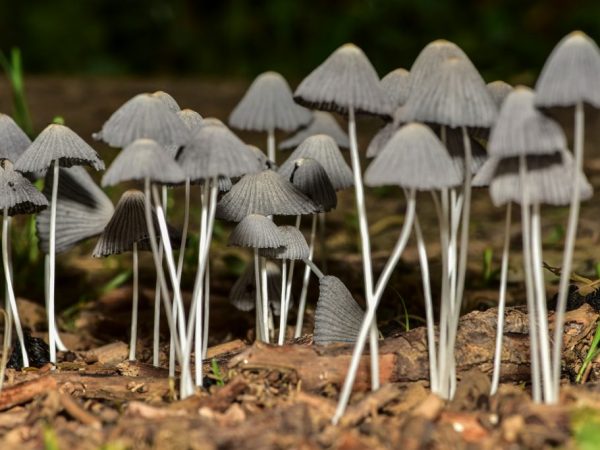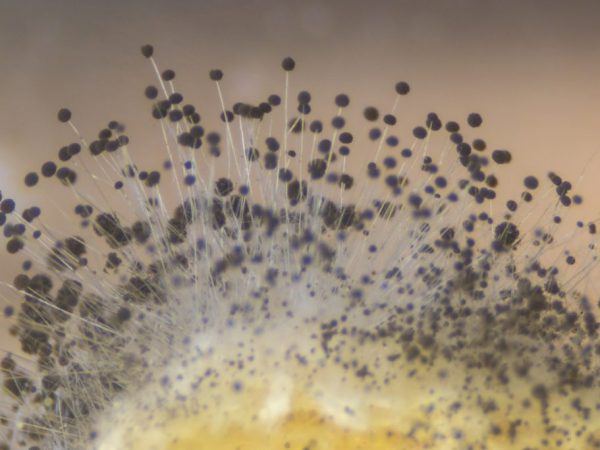Description of saprotroph fungi
There is a kind of fungi that feed on dead remains, and there are those that consume the nutrients of living organisms. Saprophytic fungi settle and feed on the remains of animals or plants (scavengers), or excrement.

Description of saprotroph fungi
Saprophytes
Both bacteria and fungi are saprophytes. Bacteria belonging to this group feed on organic matter from dead organisms. The group of saprotrophs includes lactic acid, soil, butyric acid bacteria and others. This type of fungi includes organisms that develop on humus of plant origin. They can be divided into two groups - edible and inedible.
Suitable for eating
Examples of mushrooms that will not harm your health:
- Champignon;
- raincoats;
- umbrellas;
- morels;
- dung beetles;
- lines (after preprocessing);
- cystoderm;
- cobwebs.
Unsuitable for eating
These organisms should not be eaten:
- pigs;
- helwell;
- pale toadstools;
- spring toadstools;
- white toadstools.
Structure and methods of nutrition
The species saprophytes or saprotrophs are fungi that form many spores during their life. They scatter to surrounding plants or animal remains, contributing to the reproduction and settlement of the mycelium. Examples of vegetation that organisms like to settle on:
- cones;
- branches;
- hemp;
- stalks of annual grasses;
- needles and foliage;
- feathers and horns.
Different saprophytes, or, as they are also called, decomposers, are characterized by a different type of substrate on which they settle and live. So, for summer honeydew, the best food is the remains of deciduous trees. False mushrooms eat only needles. But the white dung beetle wonderfully exists in places that are highly saturated with nitrogen.
What are saprophytic mushrooms

Representatives of the genera Penicillus and Mukor cause spoilage of food
The variety of saprophytes is surprising. The most famous names are:
Mukor: it is an inferior mold. Included in the Zygomycete class. He is aerobic, that is, existence is impossible without oxygen. The mycelium of mucor is unicellular, has many nuclei. All representatives of this genus settle in the upper layers of the soil, horse manure, food and organic debris. The body of this organism looks like thin threads - it is the mycelium. On the branches or hyphae of the mycelium, small black heads grow, in which there are spores. Mucor feeds on organic matter. Scavenger mushroom, as it is also called, because it does not leave waste. Mucor can appear on a living, but sick organism. When he dies, all the remains are recycled.
Aspergill: mold, which belongs to the highest aerobic. The genus of these organisms has hundreds of species. All of them are quite common and grow in different climatic zones. They take root on various substrates and create fluffy white colonies. But over time, the color changes. Aspergillus has strong mycelium and septa.It reproduces, like other saprotrophs, by spores. The organism lives in soil, which contains a lot of oxygen. The organism appears as mold on top of the substrate. It is this mushroom that is dangerous. It attacks foods that have starch in their structure. The organism grows inside and on the surface of the tree.
Irina Selyutina (Biologist):
Mushrooms of the genus Aspergill were first described (cataloged) in 1729 by the Italian P. Mikheli. Although their natural habitat is the upper soil horizons, especially in southern latitudes, they are most often found on various products, mainly of plant origin. The vegetative body of Aspergillus is a multicellular and highly branched mycelium. Mycelium cells are multinucleated. The fungus is also characterized by the ability to form aerial mycelium. The representatives of the Aspergillus niger group, which are most actively used in industry and laboratory research, are of the greatest practical importance. At one time the species A. niger was figuratively named by LI Kursanov "biochemical frog". Aspergillus differs from penilla and mucor in that their fruiting filaments at their apex have thickenings with rod-like outgrowths, which in general resembles a "shaggy head". Chains of spores are detached from these outgrowths.
Penicillium: these representatives of higher fungi are not uncommon in nature. They are classified as imperfect mushrooms. Of particular value is the green racemose mold - golden penicillus. The well-known antibiotic penicillin is produced from it. Penicillus lives in the soil. The structure is similar to the structure of the aspergillus fungus. Vegetative mycelium is branched, colorless and multicellular. In this (structure), the penicillus mushroom differs from mucor - the latter has the simplest mycelium. The body's hyphae are immersed in the substrate or located on its surface. Erect conidiophores form tassels that carry chains with spores. These chains have from one to three tiers, they can also be asymmetrical. These mushrooms reproduce by spores. Saturated by absorbing organic matter. Some of the representatives are weak plant parasites. The development of the penicillus leads to food spoilage.
What is the difference between saprophytes, symbionts and parasites
There are fungi, parasites, saprophytes and symbionts. The difference lies in the way of eating.
Saprophytes
They prefer the substances of dead organisms as a source of food. These are bacteria such as E. coli or certain types of fungi - penicilli. Saprophytes or saprotrophs are a kind of orderlies in nature, because their main function is to recycle waste.
Symbionts
These are organisms that enter into symbiosis with other species, and receive mutual or one-sided benefits from this. Not only aquatic, but also terrestrial organisms participate in such relationships. Symbionts create a beneficial bond with each other, with fungi, bacteria and multicellular organisms. But the number of algae susceptible to symbiosis is small.
Parasites
They exist at the expense of living organisms, feeding on their living flesh. Parasites spend almost their entire life in the host's body. They not only reduce the amount of nutrients, but also poison the host organism.
It is interesting that pathogenic fungi also lead a saprophytic and parasitic lifestyle. These microorganisms of various origins live in different places and conditions. Such organisms play an important role in science, so they are specially grown in an artificial environment for study. The following types of environment are distinguished:
- Non-selective: the most popular type for is Saburo agar. It is high in carbohydrates. Often the medium is transformed by the addition of antibiotics, cycloheximide or chlorhexidine. And also for the isolation of fastidious pathogens, the medium is enriched with 5–10% CA by adding heart and brain extracts.
- Selective: such a medium is obtained from a non-selective substrate by adding penicillin, streptomycin and chloramphenicol.
Physiology of fungi
Two groups can be distinguished:
- Mushrooms choose live plants or producers for their existence. These mushrooms are nourished by living plant cells. Do not grow on artificial soil.
- Mushrooms live on plant debris or decaying organic matter. But there are few such representatives, basically these organisms can move from one phase to another.
So, autumn honey agaric is a saprophyte and develops on dead stumps. Sometimes it grows on living trees, and in such conditions it becomes a parasite. But parasitic tinder fungi living on living plants are found from time to time on the dead parts of the tree. There are cases when fungi in different stages can behave both as saprophytes and as parasites. And even a typical parasite can be grown in an artificial nutrient soil called agar.
Conclusion
Saprophytes return the processed biomass to the soil and thereby improve the living conditions for plants, without them the circulation of substances in nature will simply stop.



